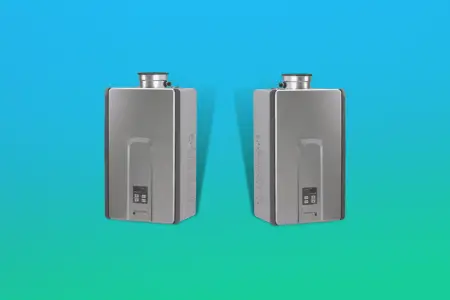Flushing your Rinnai tankless water heater is something you should do every year to prevent the buildup of minerals and deposits accumulated inside the heater. This build up is caused by hard water and can cause problems in the future by restricting the inlet and outlet water flow. Fortunately, flushing a Rinnai tankless water heater is a fairly simple process: In most cases, a few tools and half an hour are all that is required. Here is a step by step guide of how to flush your Rinnai Tankless water heater yourself and save money while learning a new skill.
How to Flush your Rinnai Tankless Water Heater
The process of flushing a Rinnai tankless water heater begins with gathering the tools needed to perform the job correctly. These may include, but are not limited to:
- Small pipe wrench
- Open jaw pliers
- Three (3) 5 gallon buckets (one with a lid)
- Two (2) washer hoses
- Submersible pump capable of 4 gallons per minute
- Four (4) gallons of white vinegar
Step 1
To begin the process, the first step is to turn off the tankless water heater. This is important, because the water heater will begin pumping water if the water heater turns on. If the system is open when this happens, the result will be a mess.
Step 2
The next step is to close both the hot and cold isolation valves and connect the two water hoses to the service ports on the isolation valves. This is to allow the vinegar solution to circulate through the valves and pipes.
Step 3
Next, the cold side of the isolation valve is connected to the submersible pump. This will introduce the vinegar solution into the system continuously until the flushing is completed.
Step 4
Then, using the other washer hose, the hot side is connected to the discharge side, which will empty into the bucket. The amount of solution pumped out of the system may slightly exceed the amount pumped in, because it will also be removing the minerals and deposits left behind by the hard water. This is why the capacity of the bucket (5 gallons) is larger than the amount of the solution (4 gallons).
Step 5
Next, the vinegar is poured into the bucket and the submersible pump is turned on. This will pump the solution throughout the system. Most manufacturers recommend flushing the system for at least 45 minutes, but the longer the better, especially in areas with very hard water supplies.
Step 6
If a professional is hired to flush the system, they will often use the wait incurred by the flushing to perform other maintenance. Rinnai tankless water heaters contain components such as a blower fan, burners (for gas) and the fins on the heat exchanger. This is important, as these components tend to gather dust and grime due to the common location inside a garage.
Step 7
After the flushing is complete the discharged solution is discarded. This is the purpose for the bucket lid. Once the discharged solution is in the bucket, it should be closed and sealed using the lid. This is because some municipalities regulate the disposal of discharges from appliances like tankless water heaters and water conditioners, so the discharged water may need to be transported. Professionals recommend researching the local requirements for guidance.
Now any residual vinegar can be flushed from the system. This time four gallons of fresh water is placed inside the bucket with the pump and the fresh water is pumped through the system and into the third discharge bucket. The quantity put in should be very close to the amount discharged as the system should be free of deposits and mineral buildup.
Step 8
The next step is to turn off the circulation pump and close the service port on the cold inlet. Then the washer hose can be detached from the service port as well. This will restore the circulation of cold water into the heater.
Step 9
The last step is to close the service port, remove the washer hose and reopen the isolation valve. Next, the cold inlet valve is opened to allow fresh water to flush the system a third time, but this time the water does not need to be collected.
FAQ Flushing Rinnai Water Heater
How often should I flush my Rinnai tankless water heater?
The nature of tankless water heaters requires that they be flushed out periodically. This is due to the minerals and deposits left behind by the hard water supply feeding the heater. It is estimated that in the United States, approximately 80% of consumers have hard water being used for everything from drinking water to showers. As such, for those consumers with a tankless water heater system it is recommended they flush the entire system at least annually. Some manufacturers recommend flushing the system every six months, depending on the water hardness of the region.
Can I flush out my Rinnai tankless water heater myself?
In most cases, absolutely. Flushing the system is fairly simple and straightforward, however tools and plumbing parts will be involved. For those do-it-yourselfers that struggle with, or are uncomfortable with plumbing tools and techniques, hiring a professional is a good idea. Flushing the system requires only a few parts and tools, but the project will involve a few steps that must be performed in order or the results will be unsatisfactory.
What is the best way to flush out a Rinnai tankless water heater?
This will likely depend on how adept the person doing the flushing is with tools and following directions closely. For example, a typical do-it-yourselfer will usually be familiar with common tools such as wrenches, screwdrivers, and pliers. Flushing a Rinnai tankless water heater will require only a couple of hand tools and a few common household items.
For those new to DIY, an alternate approach may be to use a tankless water heater flushing kit. These kits include the aforementioned parts in the correct quantities and are fairly universal. However, it is strongly recommended to follow the directions that came with the tankless water heater, as some manufacturers require very specific procedures to avoid damaging the unit.
Conclusion
Flushing out a Rinnai tankless water heater is designed to be relatively easy. No special tools or training is typically required, so most homeowners can perform the task successfully.
The main things to keep in mind are to have the correct materials available, follow the manufacturer’s instructions carefully, and above all, be safe.

Nick Lopresti is the founder of YourH2Home and a home improvement expert. He has years of experience writing about various home improvement topics, mostly as it pertains to water systems.
